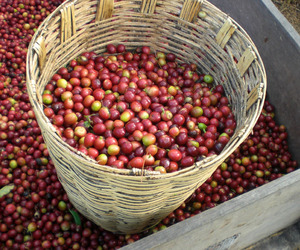
© Sustainable Harvest, Oaxaca, 2009
For many foreigners living in Mexico, this is their first experience of life in a coffee growing country. Familiar brands from home are hard to find, but Mexican coffee is everywhere, in a wide range of quality and price.
I live at the Chapala Lakeside at over 5,000 feet in elevation and, unlike up north, here one drinks and brews with bottled or filtered water as a matter of course. All of these factors have important effects on the flavor of your morning cup. Let’s talk about coffee.
What is coffee?
Coffee is the seed or pit of a cherry that grows on a tropical evergreen shrub. There are two coffee beans per cherry, and it takes about 4,000 beans to make a pound of coffee — equivalent to the annual production of one coffee tree! For high-quality coffee, the cherries must be selectively hand-picked as they ripen. After picking, the beans are removed from the cherries, either using water (wet method) or by drying in the sun. Then they are either fermented, rinsed and dried (wet process) or winnowed and sorted (dry). They are then graded (sized), further sorted by hand and bagged for export. It is an exceedingly labor-intensive process, especially for the higher-quality specialty coffees that comprise less than 10% of world production, and which will be the sole focus of this article.
Coffee is native to Ethiopia and was first cultivated across the Red Sea in Yemen (known in ancient times as Arabia, whence arabica, the name of the best-tasting species of coffee). Outside of these lands, coffee is a colonial crop grown for export to the first world. Many farmers — even wealthy ones with large plantations — have most often not even tasted their own harvest. Mexico is a particularly strong instance of coffee as colonial crop, with only about 200 years of history growing it and almost no coffee culture compared even to other Latin American countries.
Mexican growing regions
While coffee is grown in many parts of Mexico, there are two growing areas that produce the best coffee: Chiapas and Oaxaca.
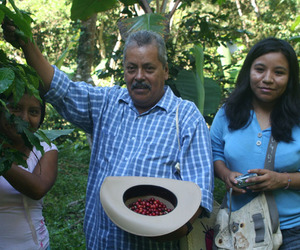
Both of these regions produce large quantities of certified organic, fair trade coffee. But these certification don’t have anything to do with the flavor or quality of the coffee, nor do they, in and of themselves, assure farm worker welfare or healthy ecosystems. Being willing to pay a premium price for quality coffee, certified or not, is of the greatest value in supporting sustainably-grown coffee’s continued availability.
The third noteworthy growing area is in the mountains outside of Xalapa in Veracruz, and these are generally milder tasting, sound but unremarkable coffees.
Traveling around Mexico, you’re most likely to be served instant coffee. Next up the quality ladder is strong drip coffee often made from darkly-roasted beans not deemed fit for export. The dark roast disguises defects, and these coffees are often “finished” by dumping sugar into the roaster at the end of the roast cycle, resulting in an agreeable burnt caramel sweetness. Served with hot milk, this is much better than a typical American diner brew.
Café de OllaYou need:
Bring the water to a boil. Add the cinnamon and sugar, stirring or whisking to dissolve the latter and tasting for sweetness. Add the coffee. Bring to a boil twice, strain through a fine mesh strainer and serve, with warm milk or half-and-half. |
Harder to find but well worth seeking out (and even more worth making at home) is café de olla, “coffee of the pot,” brewed with the raw brown sugar called piloncillo and laced with stick cinnamon. This “Mexican chai” is delicious and the best use of most Mexican coffee.
Placing Mexican coffee in context
Your degree of satisfaction with Mexican coffee depends on what you’re used to in terms of origin, roast and freshness. Having worked in coffee for many years, I naturally compare Mexican coffee with top-quality beans from every other origin country, and by that standard the very best Mexican coffee is… okay. This isn’t to say it can’t be delicious, but if you’re looking for Sumatran creamy earthiness, the zing of a top Kenya or the lemony perfume of an Ethiopian Yergacheffe you’d better buy your beans in the U.S.
While there are some superb Mexican coffees, they’re all exported to Europe and, to a lesser degree, the U.S. Mexico is not unique in this regard: every producing country exports almost all its top-quality coffees and keeps the rest for domestic consumption. The best that’s available — and it’s plenty delicious, fresh and well-priced — are middle-of-the pack regional coffees from Chiapas and Oaxaca, often certified organic and fair trade. Roasting tends to be “rustic” and on the dark side, and you must be vigilant about freshness (see below). And if you’re an espresso connoisseur, either lower your standards for cappuccino in cafés or plan on brewing better at home, since knowledge of proper brewing is just as scarce as farmers who drink their own beans.
Prepackaged whole beans or ground coffee in valve bags are almost certain to be stale, especially when packed by small-scale Mexican roasters who often lack the necessary equipment to remove oxygen from the bags before sealing. The one reliable exception to this rule would be Starbucks products purchased either at their stores or at Costco.
There are small roasters specializing in coffees from their regions in Oaxaca City, San Cristobal de las Casas, Xalapa (and doubtless many other places), and at least one craft roaster in San Miguel de Allende as well. Before you buy beans — anywhere — make sure the coffee is within five days of roast (recien tostado — “recently roasted” — is not good enough), and that they know where it’s from. Coffee has the shelf life of fresh-baked bread, but most of us grow up thinking of it as a staple, like the flour the bread is made from!
Degrees of roast
There is no standardized roast terminology, so one roaster’s “French” might equal another’s “Italian.” In the U.S. and, to a lesser extent Canada, Starbucks and its many imitators have done a good job of conditioning people to associate high quality — or, at the very least, a high price — with incinerated beans buried in steamed milk, but professional tasters have no interest in dark roasts, which taste like process, not product. (A really dark “West Coast” French roast is about 20% carbon.) Neither, for that matter, do we have any affection for the ultra-light “cinnamon roast” used for Folger’s and other institutional American coffees. Between acid and burnt there are a wide range of flavorful shades well worth exploring, and I’d encourage you to seek them out.
Best Brewing Methods
|
Peak varietal expression in coffee is achieved at a medium chestnut brown color (with no oil on the bean surface) called “full city.” Lighter than that and acidity and aroma are highlighted at the expense of body; darker and you get heavy bodied coffee with sweetness but more murky varietal notes and subdued aroma — until you get to the seriously dark, nearly black roasts that are very common in Mexico.
French Roast is bitter but light in body, and though many consumers think of it as strong coffee, it’s actually lower in caffeine than lighter roasts that have more soluble solids remaining in them. The good news if you’re a French Roast fan is that you can be very happy drinking Mexican coffee, much of which is very darkly roasted for the simple reason that such roasts mask the flavor defects typical of lower quality beans.
Whatever your preferred degree of roast, please be aware that even if you are a French Roast aficionado, that’s not the roast to be using to brew espresso. Espresso machines are unique in that they use pressure rather than gravity to brew, and that extraction greatly amplifies both acidity and bitterness. Classic espresso roasts are no more than a deep dark chocolate brown.
Freshness is vitally important
Green (unroasted) coffee beans stay fresh for up to a year. But once roasted, whole beans are stale in a week. Just-roasted coffee releases a minimum of three times its volume in carbon dioxide gas, so the only way to put it in a can or typical brick pack is to grind it and let it get almost completely stale first.
The introduction of the one-way valve bag in the 1970s revolutionized coffee packaging. If used properly, it can extend useful shelf life for whole beans to about three months, though the coffee stews in its own juices and isn’t truly fresh roasted. To be clear, fresh roasted coffee is coffee within one week of roast date regardless of how it’s packaged, and that’s the only kind of coffee to be buying. In Mexico, this means buying from the roaster directly, not at a supermarket.
Because of the far greater surface area exposed to air, drip ground coffee is stale within 24 hours of roasting. Espresso, ground far finer, is stale in an hour, which is why any espresso bar will have a doser-grinder that grinds the coffee every few minutes located right beside the espresso machine.
Storage and grinding
When freshly-roasted beans are readily available, it is best to buy your coffee fresh each week. Keep it in whole bean form in the bag it comes in on your counter or in a cool place away from spices, and grind it fresh each morning. If it’s imperative to store coffee longer, transfer it to an airtight container and keep it in the freezer for up to a couple of months, grinding the frozen beans (never thaw and re-freeze) as needed. (This is a Mexico-specific recommendation: freezing of beans from other origins with more fragile and complex aromatics isn’t recommended.)
Assuming that you buy truly roaster-fresh coffee, the two other factors that will make the biggest difference in the quality of the coffee you enjoy are:
- Grinding just before brewing and
- Using the correct coffee: water ratio (see below).
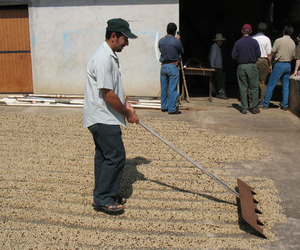
Burr grinders that actually cut the beans are best, but an inexpensive blade grinder works just fine for any brewing method except espresso. The reason why this is important is very simple: oxygen is coffee’s biggest enemy, and whole beans expose very little surface area to air compared to ground coffee. At room temperature, it’s a difference between staying fresh for a week or becoming stale in 24 hours.
Grind size is a function of brewing time. The faster the brewing method, the finer the grind, and vice versa, in order to extract just the desirable “heart” of the coffee without wateriness (too coarse a grind) or bitterness (too fine a grind and/or too little coffee). For the most popular brewing methods, here are approximate grind times in a blade grinder:
- ” French Press (plunger pot) and “open pot” or cowboy coffee (including café de olla): 10 seconds – coarse grind
- ” Manual or electric drip, vacuum pot: 15 seconds, medium grind
- ” Aeropress (see below) 17-20 seconds
Finer grinds than these are suited only to commercial-quality espresso machines, which in order to function properly require a specially designed doser-grinder capable of very fine gradations in particle size. Using finely (“espresso”) ground coffee in a drip brewer (a classic error called “grind finer, use less”) results in bitter, over-extracted coffee every time.
Water type and temperature
The best water for brewing coffee or tea is fresh spring water free from off tastes and odors with a low mineral content (around 3 grains of hardness). Throughout Mexico, what’s commonly available is bottled water that has been through carbon filtration, ultraviolet (UV) radiation to kill bacteria, and reverse osmosis or, less commonly, water from sink-mounted or whole house systems that use carbon and UV only.
Commercial bottled water here varies quite a bit depending on how frequently the company changes its filters, but it’s generally flat tasting and very low in minerals (RO essentially takes out everything, including the modicum of minerals needed for good flavor). If bottled water is your mainstay, try pouring the required quantity back and forth between two pitchers a few times to oxygenate it (greatly improves the flavor) and, if you’re truly fanatical like I am, you can add about 10% boiled unfiltered local tap water to bring up the mineral content.
If you have a sink or whole-house UV system, your water probably tastes good thanks to all the minerals in it, but it’s way too hard to brew good coffee. For coffee making purposes you’ll want to mix it with 1/2 to 2/3 distilled or conventional Mexican bottled water.
For all brewing methods except espresso, optimal brewing temperature is 195-205 degrees F. (90-96 C.). I live at the Chapala lakeside with an altitude of 5,000 feet, and the boiling temperature of water decreases 2 degrees F. for every 1,000 feet of altitude gain, meaning that a full rolling boil here is 202 F., not 212 as it is at sea level.
Typical home electric drip coffee makers (including costly brands like Krups, Braun and Cuisinart) don’t get water nearly hot enough to brew good coffee — even at sea level. At higher altitudes, brewing with water at a full rolling boil is mandatory.
For most people, the most dramatic difference in flavor they’re likely to see will come from boiling water in a kettle on the stove and using a plain old pour-over (manual) drip pot. I should also mention that when brewing by hand the contact time between grounds and water is also optimal: 4 to 6 minutes. Any longer than that (and the average Krups or Braun takes over 11 minutes to brew!) and the result, again, is bitterness. Now all commercial coffee makers meet the required temperature and brew time requirements without difficulty, but the only home unit that does is called the Technivorm (available online in the U.S.) and it costs $250, though it will last you a lifetime. So, if you’ve ever wondered why the coffee you brew at home never tastes as good as that from your favorite coffeehouse… now you know.
Proportion
How much coffee do I use? For any method other than espresso, optimum flavor will be achieved at 60 to 70 grams per liter (roughly two dryweight ounces per quart). Volumetrically, that is one heaping standard coffee measure (2 Tbs.) of beans or ground for every 6 fl. ounces of water. A coffee “cup” is based on a fine china cup — half the size of a typical American mug.
Cup markings on home drip brewers vary tremendously so, in order to figure out the correct dose for your particular brewer, it’s necessary to fill the container with water, pour it out into a measuring cup and divide the fluid ounce total by 6. If you’re lucky enough to have a brewer such as a 1 liter French Press or any other 1 quart unit, you’ll be happy to know that a full blade grinder’s worth of beans will weigh out to right around 60 to 70 grams depending on degree of roast.
For most folks new to great coffee, this will be way more coffee, at a much coarser grind, than they are used to using, but the result in the cup is much smoother, richer and far less bitter coffee. Using less coffee and/or a finer grind makes for an irremediably bitter brew, whereas coffee brewed at the upper end of the recommended range and then diluted to taste with hot water is smooth as silk.
Best Brewing Methods
Vacuum and drip
The vacuum pot is now obscure but is worth mentioning as it is the optimal method for brewing complexly aromatic, lightly-roasted coffees of supreme quality, such as a grand cru Kenya, Ethiopian Yergacheffe or single-farm Guatemelan Huehuetenango. Excellent examples are made by Bodum (see below) and others.
Pour-over or electric drip coffee is a convenience-oriented analogue to the vacuum pot, and the result can be excellent provided that the water is hot enough, brew time mercifully brief, and the correct amount of fresh-roasted coffee is used. Here, too, Bodum makes the best pot, but regular old manual Melittas work fine too.
If you use a drip maker, buy only white (never brown) filters and give them a rinse before putting the coffee in to remove some of the paper taste.
Drip or vacuum pot coffee is clean-tasting due to lack of sediment and relatively light-bodied. It remains palatable on a burner for 20 minutes or can last up to an hour when brewed into or transferred into a thermal container.
Open pot
Open pot methods are infusions wherein all of the grounds are mixed with all of the water, after which the infusion is filtered to remove some but not all of the flavorful oils and fine particles. Cowboy coffee, café de olla and French Press or plunger pot coffee are all open pot methods.
The French Press is without a doubt the easiest way to brew superb coffee. A tempered glass or stainless steel beaker is preheated with boiling water, coarse-ground coffee is added, then hot water. After steeping for four minutes, a plunger containing a steel filter and fine mesh disk are plunged through the grounds. The brew is very full bodied and satisfying, though some find the small amount of sediment and oils off-putting. For medium-dark roasts or darker, for those who enjoy milk or cream in their coffee, or for those outside of Mexico who dote on coffees such as Sumatra where body rather than high notes are the attraction, this is the supreme brewing method other than espresso.
Plunger pots can be had, at a stiff price, at Liverpool and Starbucks stores in Guadalajara but are probably best ordered online from the U.S. For all of these methods the best source is the world’s premier manufacturer of handmade coffee and tea brewing devices, at www.bodumusa.com
Espresso and the Aeropress alternative
Espresso is to other brewing methods what graduate school is to kindergarten. The main obstacle to doing it at home is: most of us are failing kindergarten.
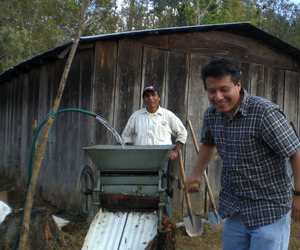
© Sustainable Harvest, Oaxaca, 2009
Everything that matters for these other brewing methods (provenance and age of the green beans, roast, bean freshness, grind size, temperature and freshness, water quality and temperature, equipment, and above all operator knowledge and care) matters ten times more for espresso.
In Italy, espresso’s home land, people use an inexpensive aluminum stovetop maker to make what is called caffe. Caffe is double-strength coffee, not espresso — for espresso, you head down to the neighborhood coffee bar, where a man (almost always a man) or his son with decades of experience and $5,000 to 10,000 worth of commercial espresso machine and doser-grinder work their magic. Italians know better than to try to pull off “home espresso,” and most of us would do well to learn from their example.
Now Italians mostly drink straight shots of espresso — cappuccinos and the occasional caffe latte are strictly morning drinks and they are 5 to 6 fl. ounces, whereas the typical American, when they say “espresso,” really means a bit of coffee in a Big Gulp of steamed milk and sugary flavorings. This difference matters, because if what you dote on is actual espresso you need a commercial quality machine, grinder and training, while if what you’re after is simply a strong, smooth shot of coffee with some foamy milk in it you can achieve that quickly, easily and cheaply.
For the coffee part, use a French Press and brew with 50% more grounds than usual, or, better still, buy an Aeropress for what I believe to be the most ideal coffee maker of all for Mexican beans. For the frothed milk, you can buy a battery-operated frother or a microwave one, from such companies as Bodum or Aeropress (all available from their respective websites or at www.amazon.com). The entire setup will cost you around $50 U.S. and last for years.
The Aeropress: the best overall coffee maker, hands-down
The Aeropress is wonderful little device brews espresso-strength coffee of superb quality, and the extract produced can easily be diluted with hot water (i.e. made into a Caffe Americano) whose quality rivals (and for sheer sweetness surpasses) that produced by a skilled operator using a state-of-the-art commercial espresso machine. Two quick (30 second) brew cycles yields enough extract for a liter of finished drip-strength coffee so luscious that everyone I’ve served it to has said it’s the best cup of coffee they’ve ever tasted.
How good is it? Well with French Press (plunger pot), vacuum pot and first-rate drip brewers available to us the Aeropress is the only thing I’ve chosen to use to brew coffee (other than the occasional pot of café de olla since I bought it nearly a year ago. Dollar-for-dollar, the best coffee maker you’ll ever find (about $25 from Amazon).
A word about decaf
The good news/bad news: the good news is that contrary to rumor all commercial decaffeination methods are safe (no harmful chemicals in the finished brewed product – and no need to pay a premium for Swiss Water® or other so-called “chemical free” methods). The bad news is that all decaffeination methods remove considerable flavor and aroma from the coffee, which means that in order for the decaf to taste great, the beans chosen for decaffeination need to be stellar. That is very unlikely to be the case, for several reasons:
- The decaf drinker doesn’t expect to pay more per cup even though decaffeination is costly, so cheaper beans are used to keep the cost down:
- Custom decaffeination (called “toll decaffeination”) is costly and can only be done by larger companies with sophisticated customer bases;
- The decaf drinker is assumed by many roasters to be someone who doesn’t care about flavor in the first place and will take what they get without complaint.
In the U.S. you can get some pretty great decaf from a number of sources: the aforementioned Terroir Coffee for lighter roasts, and for deeply-roasted plunger pot or espresso-style decaf try the Sumatra or any other decaf from Peets (www.peets.com). In Mexico about your only hope is to be a French Roast lover, in which case the darkest available decaf from any local roaster may suffice. Otherwise, it’s time to explore the wide world of herb tea, and fortunately Mexico has some great ones, including hierabuena (spearmint) and manzanilla (chamomile).

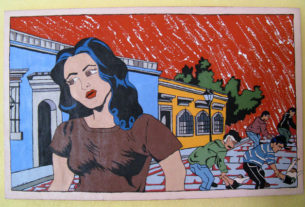
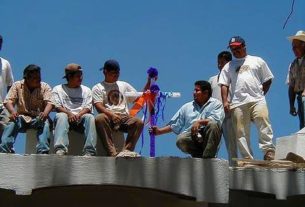
Kevin, do you know a coffee roaster in Cancun?